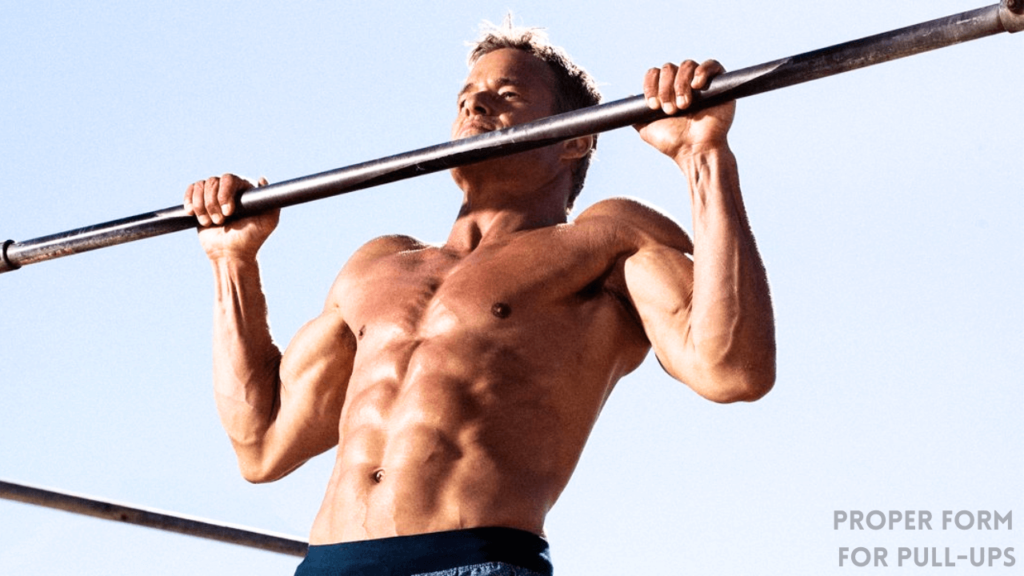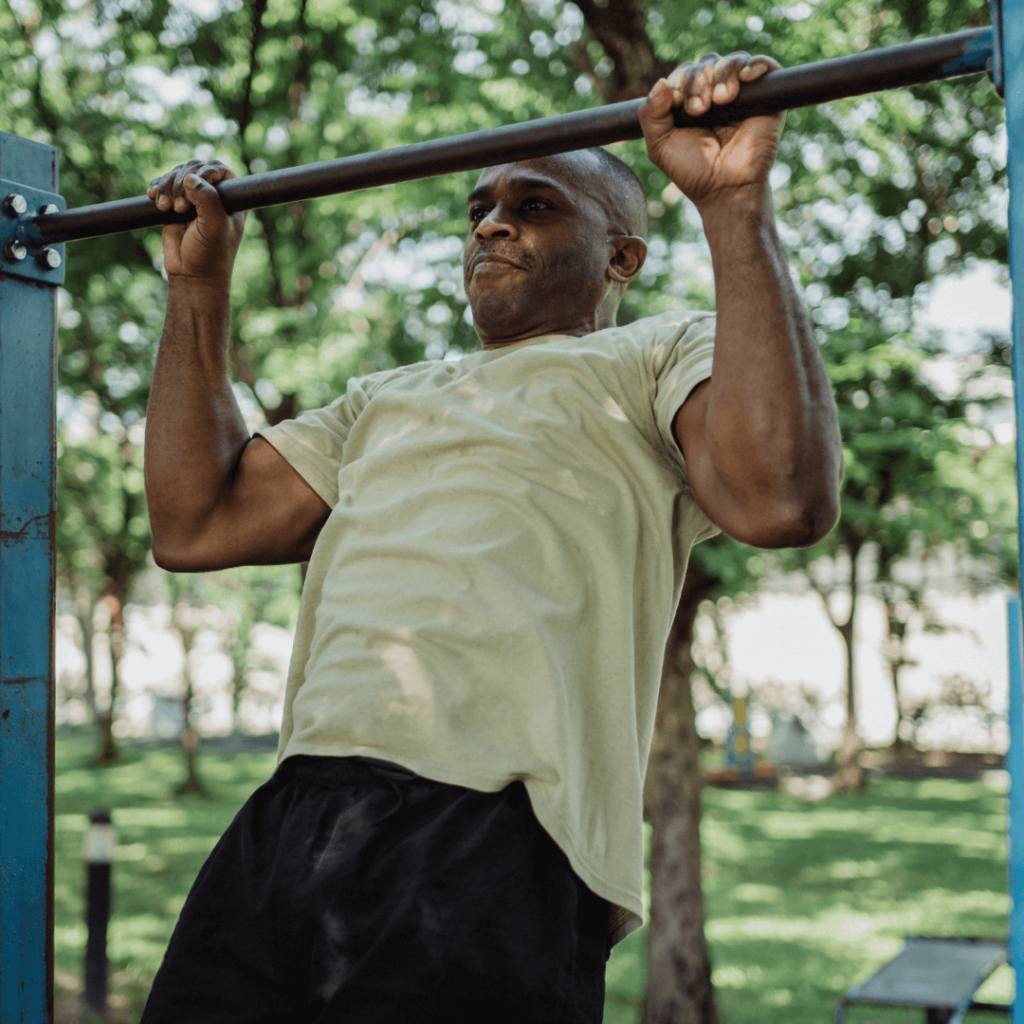Pull-ups are an exceptional body-weight exercise that can help you develop significant upper body and core strength.
While they may seem daunting, with practice and proper form, anyone can conquer pull-ups and reap numerous benefits.
This comprehensive guide will debate the advantages of pull-ups, offer essential tips for perfect form, and provide modifications suitable for every stage of your pull-up journey. So let’s get started!
Benefits of Pull-Ups
Here are the Benefits of the Pull-ups:
Build a Stronger Back and Arms

Pull-ups are widely regarded as a gold standard exercise for developing back strength. This compound movement targets the latissimus dorsi and rhomboid muscles in the middle and upper back, contributing to a well-developed back.
Additionally, pull-ups engage the biceps and forearm flexors, promoting arm muscle growth.
Strengthen Your Core
While primarily an upper-body exercise, pull-ups also activate the core muscles. Maintaining proper body position during the movement requires engaging the core for stability and enhancing overall core strength.
This strength and stability can positively transfer to other exercises and daily activities.
Minimal Equipment Requirements
The beauty of pull-ups lies in their simplicity. All you need is a sturdy bar or handles, making it a versatile exercise that can be performed at a gym, at home, or even in outdoor settings like parks.
Investing in a doorframe pull-up bar or utilizing existing structures like monkey bars opens up opportunities for training convenience.
Proper Form for Pull-Ups

Executing pull-ups with proper form ensures maximum effectiveness and minimizes the risk of injury.
Follow these steps for optimal technique:
Set-Up
Position a box or platform underneath the pull-up bar, allowing you to reach it comfortably. Stand on the platform and grip the bar with your palms facing you.
Carefully step off the box, creating a dead hang position with straight legs slightly in front of you and fully extended arms above your head.
Initiate the Movement
Relax your shoulders and pull your shoulder blades down, engaging the back muscles. Activate your back, core, and glutes to pull yourself upward until your chin clears the bar.
Maintain a downward shoulder position and avoid shrugging.
Full Range of Motion
Complete the repetition by lowering yourself into a full dead hang position with extended arms.
Emphasize using a complete range of motion, ensuring your chest touches the bar during the upward phase and achieving a full extension during the downward phase.
Pull-Ups vs Chin-Ups: Understanding the Difference
Pull-ups and chin-ups are two variations of the same exercise but differ in hand positioning:
Pull-Ups

Pull-ups are performed with a pronated grip, meaning your palms face away from you. This grip primarily targets the latissimus dorsi and rhomboid muscles, with less assistance from the biceps.
Chin-ups

Chin-ups utilize a supinated or neutral grip, with palms facing toward you or facing each other. This grip places more emphasis on the biceps while still engaging the same back muscles as pull-ups.
Common Mistakes and How to Correct Them
To ensure you get the most out of your pull-up training, avoid these common mistakes:
Incomplete Range of Motion
One of the most prevalent errors is failing to perform a full range of motion. Strive to pull yourself up until your chest touches the bar and lower yourself into a complete dead hang.
Emphasizing a complete range of motion will enhance your strength gains in the long run.
Shoulder Shrugging
Shrug avoidance is crucial during pull-ups, shifting the workload from the targeted muscles to the upper traps.
Keep your shoulders away from your ears throughout the exercise, maintaining proper muscle engagement.
Lower Back Arching
Arching the lower back compromises the effectiveness of pull-ups. Aim for a stable position that integrates your core with your upper body.
Keep your ribs down, legs slightly in front of your body, and actively squeeze your thighs together to stabilize your core and prevent excessive lower back extension.
Modifications to Make Pull-Ups Easier
If you’re unable to perform a full unassisted pull-up, these modifications can help you progress towards achieving one:
Barbell Inverted Row
Utilize a Smith machine or a barbell in a power rack for inverted rows. Set the barbell at chest height or slightly lower, grab the bar, and walk your feet out to create an acute angle with the floor.
Lower your body away from the bar while maintaining a plank position, and pull yourself back up until your sternum touches the bar.
TRX Chin-Up
Using a suspension trainer like a TRX can provide a less intimidating approach to practicing chin-ups and pull-ups.
Sit on the floor beneath the suspension trainer, grab the handles with your palms facing away from you, and pull yourself up until your hands reach armpit height while maintaining proper shoulder positioning.
Negative Pull-Up
Negative pull-ups focus on the movement’s eccentric (lowering) phase, allowing you to build strength even if you can’t perform a full pull-up.
Begin from the top position by jumping or stepping onto a box to create a dead hang. Slowly and controlled, lower yourself to a complete dead hang position, emphasizing a controlled descent.
Band-Assisted Pull-Up
Resistance bands can reduce the body weight you must pull against, making pull-ups more achievable.
Secure a resistance band around the pull-up bar, loop one end under the bottom of one foot, grab the bar with palms facing away from you, and perform pull-ups while relying on the assistance provided by the band.
Making Pull-Ups More Challenging

Once you’ve mastered the basic pull-up, you can intensify the exercise to continue challenging your muscles:
Play with Tempo
Manipulate the tempo of your pull-ups to increase difficulty. Slow down the eccentric phase (lowering) or add pauses at the top or bottom of the movement.
Widen Your Grip
Adjusting your hand placement on the bar can increase the challenge. Widening your grip forces your lats to work harder, providing a more intense workout.
Add Weight
Once you can comfortably perform multiple sets of 8 to 10 body-weight pull-ups, consider adding additional resistance to strengthen your muscles further.
Weighted vests, specialized belts for weighted pull-ups, or holding weights with your legs can provide the necessary challenge.
Use Rings
Gymnastics rings offer an advanced option for pull-ups. Their instability requires excellent stabilization and individually targets each arm, providing an additional challenge to your pull-up training.
Incorporating Pull-Ups Into Your Workouts
Building up to unassisted pull-ups can be gradual, requiring patience and consistency. While progressing toward your first pull-up, include the following strategies in your training routine:
Regression and Strengthening
Begin with regression exercises like barbell inverted rows or TRX chin-ups to strengthen relative pulling and reinforce the necessary muscles. Concentrate on overall strength development through compound exercises.
Volume Accumulation
Even after achieving your first pull-up, performing multiple reps can still be challenging. Accumulate more volume by incorporating short sets of pull-ups throughout your workouts.
For example, perform one rep each time you pass a pull-up bar or break down a set number of pull-ups into multiple short sets.
Form Over Repetitions
Quality always takes precedence over quantity. Focus on maintaining strict form rather than pursuing high rep counts.
Gradually increase the number of consecutive pull-ups as your strength and technique improve.
The Takeaways
Mastering pull-ups is an empowering journey that leads to significant upper-body strength and overall fitness.
By following the proper techniques, incorporating modifications, and gradually progressing, anyone can develop the ability to perform pull-ups with perfect form.
Remember to prioritize form, be consistent, and stay motivated throughout the process. With time and dedication, you’ll achieve remarkable results and enjoy the many benefits of a solid upper body.